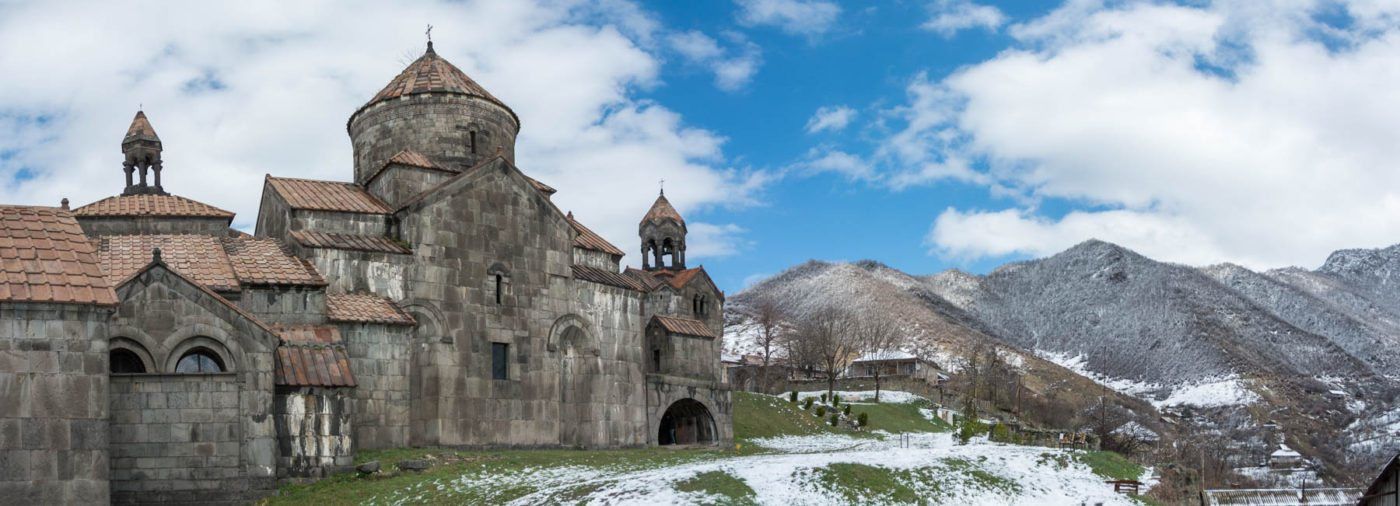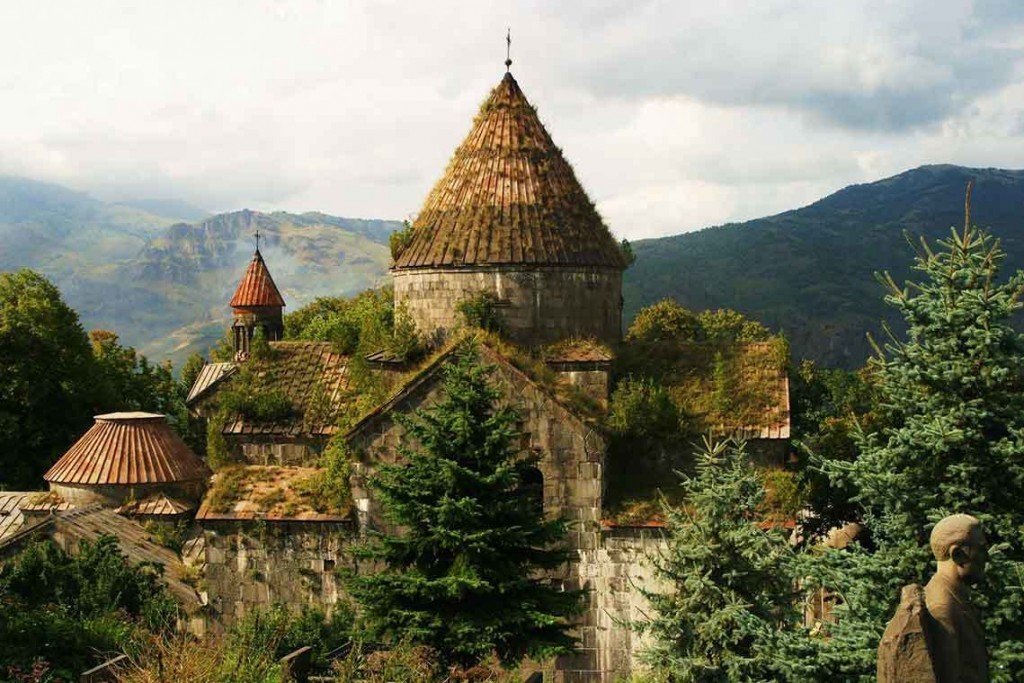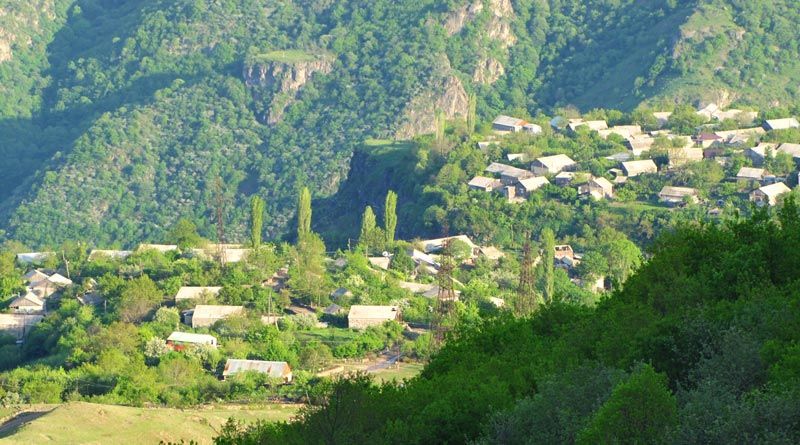Sanahin Monastery is one of the most beautiful monasteries in Armenia. The name “Sanahin” means “this one is older than that one”. It is situated in Lori province. The name of the village, where the monastery is located, is also Sanahin. In 1996, UNESCO considered Sanahin and Haghpat monasteries as a piece of world cultural heritage. Every year many tourists visit Sanahin monastery. Not only people from the abroad visit but also Armenians. Even if you go there many times, every visit will be impressive. Moreover, if you know about the history of the monastery, it will be more interesting for you.
History of Sanahin Monastery
As Sanahin and Haghpat monasteries are near to each other and almost have the same date of establishment, we learn from many books about both of them at the same time.
For getting information about Haghpat and Sanahin monasteries, there is a huge importance of lithographical inscriptions, memorials, and many architectural monuments. The historiographer of Kyurikyan Kingdom, Vanakan Vardapet (a great teacher and scientist), wrote about the history of his time, but it didn’t reach to us. His pupil Kirakos Gandzaketsi didn’t want to repeat his teacher and wrote less about Sanahin and Haghpat, especially about the Kyurikyan Kingdom. That’s why historians needed other sources to learn about the monasteries.
Old bibliographers gave contradictious information about the dates of establishment of Sanahin and Haghpat. But there is a recent important evidence in the stub of Sanahin about its date of construction. There is an unknown rewritten memorial of 972, which has a great importance for deciding the right date of the establishment of the monastery. The memorial belongs to one of the works of famous Greek scientist Barsegh Kesaratsi. In that work, the writer asked to remember about the founder and the first superior of Sanahin, who died two years ago. His name was Polikarpos. In that work, the writer tells that 972 was the 6th year of the establishment of Sanahin. This means that the monastery was established in 966 or 967.
So, if we consider the conditions of construction of middle ages, and if we count the duration of the main church as 10 years, means Katoghike church’s construction ending will be in 977. Historians connect this year to the ending of Sanahin’s construction.
The Architecture

Sanahin Monastery
Sanahin has many religious buildings in Armenian beautiful architecture. Among them, there are monuments representing exceptional value. The main group of the buildings were on a high ground, and there was a fence around it. Now, we can see only the traces of that fence. Among its main monuments group, the monastery has three churches, two yards( in which the family members of Kyurikyan Kingdom are buried and other princes and senior people). It also has a library, threshold, Academy hall and separate belfry building.
Out of the main group, the monastery has chapels and churches, as well as, the burial ground of Zaqaryans, fountain and a bridge on Debed.
As I mentioned above, there are three churches among the main group.
Astvatsatsin Church
This church is the oldest one among existing monuments. Abas king has constructed in about 951.
The church has a hall like a dome, from outside it is rectangular, and the inner side is like a cross.In middle ages, the duration of construction could last for 10 years. After the construction of this church all the buildings they built around it.
Amenaprkich Church
This is the main temple of the monastery. It built Khosrovanush queen. She established the Sanahin with the construction of the Amenaprkich church.
Like Astvatsatsin church, it also has a hall like a dome, from outside rectangular, from the inner side like a cross. It doesn’t have pillars. During Bagratunis times it became more actual to build churches without pillars. The reason of that was very simple. The churches that had no pillars seemed wider.
This magnificent temple is one of the glories of Bagratunis times after the Ani Cathedral.
Amenaprkich Chapel
The builder of the chapel is the master Zhamhayr. He built in 1181. The ecclesiastical leader of the monastery Hovhannes, Amir Kurd and Grigor Tudeordi archimandrites helped him with their funds. In the construction took part in Kyurike III’s daughters Mariam, Bavrina and Rusujan, and his wive’s aunt Rusujan. Each of them raised a pillar in the centre of the yard.
Big Yard (Gavit)
Big Gavit’s date goes back to the year of 1211. Vache prince from Vachuts dynasty helped by his fund to build this part. This building has very interesting construction. The whole building is a rectangular square from south to north, and each of its three parts has its yard and double-flat cover over them. This is a unique example in Armenian gavits.
The Academy of Master
After the two churches, they built this long hall between Astvatsatsin and Amenaprkich churches, in 11 century.
From traditions, we understand that this was the hall of the Academy, where Grigor Magistros read his lectures for the students.
Belfry
This is a three-storeyed building of the ending of the 12th century. The year of construction has no year. Like this one, but in a high architecture is the belfry of Haghpat.
Library
This building with its beautiful architecture was remarkable in middle ages. It had a reputation of having a rich manuscripts collection. Among manuscripts and books, there were valuable goods of the monastery. For that reason, the Library was also called Nshkharatun. Davit Anhoghin’s daughter Hranush ordered to build the Library.
The inner smooth walls and luxurious decorations of pillars prove the view, that that building wasn’t only a library, but also a museum, which many many visitors.
Grigor Lusavorich Church
The Hranush queen ordered to build this church 1-2 years before the construction of Writing House. This is a little church, in a round shape. Temples in this kind appeared in Bagratunis times. During the reconstruction (in 1652), they cut the upper parts.
The Burial Ground of Zaqaryans
From outside it looks like a church. Zaqare and Ivane brothers built, in 1189, on their father’s grave. Above their shrines, there are cross stones.
The Fountain
This is located at the end of the village, out of the building’s group (1255). It’s a wide structure on a hillside, from where water comes amidst the river channel.
The Bridge
The Sanahin’s bridge is a unique example of stone bridges, that came to us wholly from the 12th century. The sister of Zaqare and Ivane ordered to build that bridge. Her name was Vanini (Nana). The Bridge connects two parts of Debed. We do not use this monument but keep as a historical memorial.
The Oldest Chapel of Astvatsatsna Church
This is the oldest chapel that we have known till now. Currently, it doesn’t exist.
Sanahin Village
Sanahin was a village in Lori province. Since 1967 is a suburb of Alaverdi. It was a birthplace of the well-known Mikoyan brothers. Artyom Mikoyan was an aeroplane constructor, and Anastas Mikoyan was a politician. Anastas Mikoyan was a member of the Soviet Politburo.









Leave a Comment